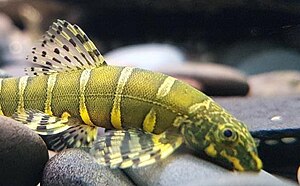Serpenticobitis
| Serpenticobitis | ||||||||||||
|---|---|---|---|---|---|---|---|---|---|---|---|---|

Banded loach ( Serpenticobitis cingulata ) |
||||||||||||
| Systematics | ||||||||||||
|
||||||||||||
| Scientific name of the family | ||||||||||||
| Serpenticobitidae | ||||||||||||
| Kottelat , 2012 | ||||||||||||
| Scientific name of the genus | ||||||||||||
| Serpenticobitis | ||||||||||||
| Roberts , 1997 |
Serpenticobitis is a genus of very small, loach-like freshwater fish thatoccursin the Mekong river basin in Southeast Asia.
features
Serpenticobitis species are 3.9 to 5.4 cm long and have a compact, cylindrical body, which is unusual for loaches. The head is small, the muzzle rounded, the small mouth below. The upper and lower lips are fleshy and fused together. The lower lip shows some wrinkles, but is not interrupted in the middle. The fish have three pairs of barbels , two on the rostrum and one on the maxillary . A large, two-tipped stinger sits just below the eye. The front nostril opens into a valve-like tube. The beginning of the dorsal fin lies in front of the base of the pelvic fin. The pelvic fins point downwards. The pectoral and pelvic fins each have a spine. The caudal fin is slightly forked. The swim bladder consists of two parts that are connected by a connecting channel, the manubrium. Species of serpenticobitis show a pattern of 7 to 9 vertical, dark bands. All fins have striking rows of dots. A large, clearly visible spot sits in the middle of the base of the caudal fin.
- Fin formula : dorsal 11–12, anal 8.
- Vortex number: 33 - 35.
species
There are three types, which are distinguished by their coloring.
- Serpenticobitis cingulata Roberts, 1997
- Serpenticobitis octozona Roberts, 1997
- Serpenticobitis zonata Kottelat, 1998
Systematics
Serpenticobitis was at first described in the family of wolffish found (Cobitidae), but later the loaches (Balitoridae) or loach assigned (Nemacheilidae). In 2012, Kottelat established the Serpenticobitidae family for the genus.
literature
- Maurice Kottelat (2012): Conspectus cobitidum: an inventory of the loaches of the world (Teleostei: Cypriniformes: Cobitoidei) . The Raffles Bulletin of Zoology, Suppl. 26: pp. 1-199. PDF
Web links
- Serpenticobitis on Fishbase.org (English)
- Serpenticobitidae on Fishbase.org (English)